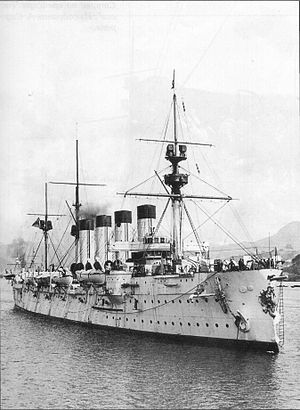
Back Россия (броненосен крайцер) Bulgarian Rossija (1896) Czech Rossija (Schiff, 1896) German Rossia (1896) Spanish ناو روسی روسیا Persian Russie (croiseur) French ロシア (装甲巡洋艦) Japanese 로시야 (장갑순양함) Korean Rossija (1896) Polish Россия (крейсер) Russian
 Rossia
| |
| Class overview | |
|---|---|
| Name | Rossia |
| Operators | |
| Preceded by | Rurik |
| Succeeded by | Gromoboi |
| Built | 1893–1896 |
| In commission | 1896–1922 |
| Planned | 1 |
| Completed | 1 |
| Scrapped | 1 |
| History | |
| Name | Rossiya (Russian: Россия) |
| Namesake | Russia |
| Operator | Imperial Russian Navy |
| Builder | Baltic Works, Saint Petersburg |
| Laid down | October 1893[Note 1] |
| Launched | 30 April 1896 |
| Commissioned | Late 1896 |
| Fate | Sold for scrap, 1 July 1922 |
| General characteristics (as built) | |
| Type | Armored cruiser |
| Displacement | 12,195 long tons (12,391 t) |
| Length | 485 ft (147.8 m) |
| Beam | 66.6 ft (20.3 m) |
| Draught | 26.2 ft (8.0 m) |
| Installed power |
|
| Propulsion | 3 shafts, 2 triple-expansion steam engines + 1 TE cruising engine |
| Speed | 19 knots (35 km/h; 22 mph) |
| Range | 7,740 nmi (14,330 km; 8,910 mi) at 10 knots (19 km/h; 12 mph) |
| Complement | 839 officers and crewmen |
| Armament |
|
| Armor |
|
Rossia (Russian: Россия) was an armored cruiser of the Imperial Russian Navy built in the 1890s. She was designed as a long-range commerce raider and served as such during the Russo-Japanese War of 1904–05. She was based in Vladivostok when the war broke out and made a number of sorties in search of Japanese shipping in the early months of the war without much success.
Rossia, along with the other armored cruisers of the Vladivostok Cruiser Squadron, attempted to rendezvous in the Strait of Tsushima with the main portion of the Pacific Fleet sailing from Port Arthur in August 1904, but were delayed and had to return to port without them. They encountered a Japanese squadron of four armored cruisers between them and their base shortly after they turned around. The Japanese sank the oldest Russian ship, Rurik, and damaged Rossia and Gromoboi during the Battle off Ulsan, but both Russian ships were repaired within two months.
After the end of the war Rossia returned to Kronstadt where she underwent a three-year refit that strengthened her armament. She was fitted with mine rails in 1914 and laid one minefield during World War I that damaged two German light cruisers. She was reconstructed beginning in late 1915 to further strengthen her armament, but played no part during the rest of the war as her crew became involved in revolutionary activities in 1917. She was taken over by the Bolsheviks in late 1917, but was put into reserve in 1918 and sold for scrap in 1922.
Cite error: There are <ref group=Note> tags on this page, but the references will not show without a {{reflist|group=Note}} template (see the help page).